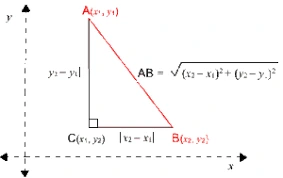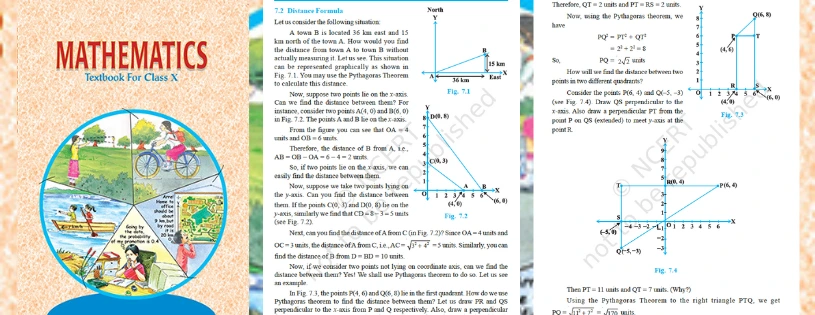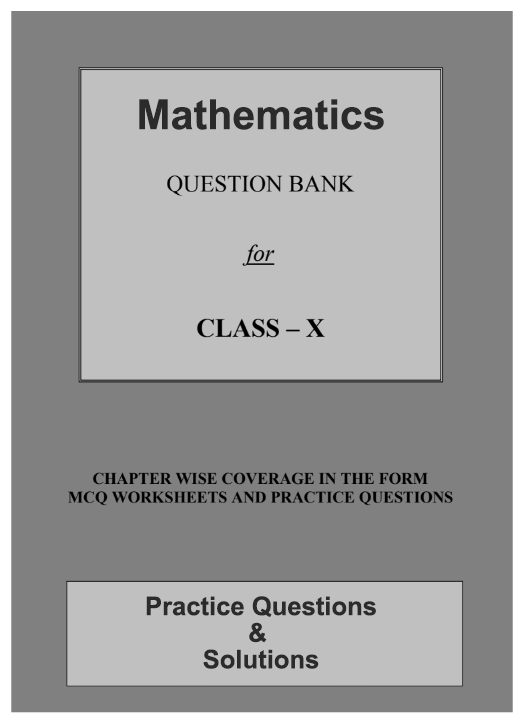In the expansive realm of Coordinate Geometry, the distance formula stands as a beacon, guiding us through the intricacies of measuring spatial relationships between points. This blog post delves into the depth of the distance formula, exploring its derivation, application, and significance in both theoretical and practical contexts.
Mastering Spatial Calculations A CBSE-NCERT Aligned Guide to the Distance Formula – Download Now
The Genesis of the Distance Formula
The distance formula is a mathematical gem that finds its roots in the Pythagorean theorem. Derived from the principles of right-angled triangles, it provides an elegant solution for calculating the distance between two points (x₁, y₁) and (x₂, y₂) on the Cartesian plane.
Distance Formula in Maths
In maths, the distance formula is defined for coordinate geometry. Students should not get confused here about the formula for speed and distance. Both are completely two different topics. When we speak about speed and distance, it is covered under real-life scenarios when a person or a vehicle moves at a speed to cover a distance at a particular interval of time. Then the speed is equal to the ratio of distance covered and time taken.

What is the distance formula?
The distance formula is the formula, which is used to find the distance between any two points, only if the coordinates are known to us. These coordinates could lie on x-axis or y-axis or both. Suppose, there are two points, say P and Q in an XY plane. The coordinates of point P are (x1,y1) and of Q are (x2,y2).

Distance Formula Examples
Let us solve some problems based on the distance formula.
Example 1: Find the distance between the two points A(1, 2) and B(-2, 2).
Solution: Given, two points A and B have coordinates (1, 2) and (-2, 2) respectively.
Let A(1, 2) = (x1, y1)
B(-2, 2) = (x2, y2)
To find: the distance between A and B
By the formula of the distance between two points,
D = √[(x2 – x1)2 + (y2 – y1)2]
AB = √[(-2 – 1)2 + (2 – 2)2]
AB = √(-3)2 + (0)2
AB = √9 = 3 units.
Unveiling the Formula
The distance formula is succinctly expressed as √((x₂ – x₁)² + (y₂ – y₁)². Breaking down this formula, we discover its components: the horizontal difference squared, the vertical difference squared, and their sum under the square root. This intuitive formula encapsulates the essence of distance calculation in a two-dimensional space.
Practical Applications
Beyond its mathematical elegance, the distance formula holds immense practical value. From navigation systems guiding us on our journeys to computer graphics rendering lifelike images, this formula is omnipresent. In physics, it aids in determining the separation between objects and plays a crucial role in solving real-world problems.
Geometric Insights
Coordinate Geometry, with the distance formula at its core, empowers us to gain profound geometric insights. Whether analyzing the dimensions of a shape or understanding the relationships between points, this formula serves as a versatile tool for exploring the spatial fabric of our mathematical world.
Extension to Three Dimensions
While initially formulated for two-dimensional space, the distance formula seamlessly extends to three dimensions. By incorporating the z-axis, mathematicians and scientists can calculate distances in a three-dimensional space, paving the way for applications in physics, engineering, and computer modeling.
CBSE Class 10th Downloadable Resources:
| 1. CBSE Class 10th Topic Wise Summary | View Page / Download |
| 2. CBSE Class 10th NCERT Books | View Page / Download |
| 3. CBSE Class 10th NCERT Solutions | View Page / Download |
| 4. CBSE Class 10th Exemplar | View Page / Download |
| 5. CBSE Class 10th Previous Year Papers | View Page / Download |
| 6. CBSE Class 10th Sample Papers | View Page / Download |
| 7. CBSE Class 10th Question Bank | View Page / Download |
| 8. CBSE Class 10th Topic Wise Revision Notes | View Page / Download |
| 9. CBSE Class 10th Last Minutes Preparation Resources (LMP) | View Page / Download |
| 10. CBSE Class 10th Best Reference Books | View Page / Download |
| 11. CBSE Class 10th Formula Booklet | View Page / Download |
Being in CBSE class 10th and considering the board examinations you must be needing resources to excel in your examinations. At TestprepKart we take great pride in providing CBSE class 10th all study resources in downloadable form for you to keep you going.
Below is the list of all CBSE class 10th Downloads available on TestprepKart for both Indian and NRI students preparing for CBSE class 10th in UAE, Oman, Qatar, Kuwait & Bahrain.
SAMPLE PRACTICE QUESTION
Q1: What does the Distance Formula measure in geometry?
Ans: The Distance Formula measures the distance between two points in a coordinate plane.
Q2: How is the Distance Formula represented and calculated?
Ans: The Distance Formula is represented as \(d = \sqrt{(x_2 – x_1)^2 + (y_2 – y_1)^2}\), where \((x_1, y_1)\) and \((x_2, y_2)\) are the coordinates of the two points.
Q3: Can you provide a step-by-step example of using the Distance Formula?
Ans: Certainly! For points \((3, 5)\) and \((7, 9)\), the distance \(d\) is calculated as \(\sqrt{(7 – 3)^2 + (9 – 5)^2}\).
Q4: What role do the differences in x and y coordinates play in the Distance Formula?
Ans: The differences (\(x_2 – x_1\) and \(y_2 – y_1\)) represent the horizontal and vertical distances between the two points, respectively.
Q5: Does the Distance Formula only apply to points in a two-dimensional plane?
Ans: The Distance Formula is primarily designed for two-dimensional coordinate planes. For three-dimensional space, an extension of the formula is used.

| CBSE CLASS 10 Mathematics Chapter |
| Chapter:1 Real Numbers |
| Chapter:2 Polynomials |
| Chapter:3 Pair of Linear Equations in Two Variables |
| Chapter:4 Quadratic Equations |
| Chapter 5. Arithmetic Progressions |
| Chapter:6 Triangles |
| Chapter:7 Coordinate Geometry |
| >Section Formula |
| Chapter:8 Introduction to Trigonometry |
| Chapter:9 Some Applications of Trigonometry |
| Chapter:10 Circles |
| Chapter:11 Areas Related to Circles |
| Chapter:12 Surface Areas and Volumes |
| Chapter:13 Statistics |
| Chapter:14 Probability |
| CBSE CLASS 10 Science Chapter |
| Chapter:1 Chemical Reactions and Equations |
| Chapter:2 Acids, Bases and Salts |
| Chapter:3 Metals and Non-metals |
| Chapter:4 Carbon and its Compounds |
| Chapter:5 Life Processes |
| Chapter:6 Control and Coordination |
| Chapter:7 How do Organisms Reproduce? |
| Chapter:8 Heredity |
| Chapter:9 Light – Reflection and Refraction |
| Chapter:10 The Human Eye and the Colourful World |
| Chapter:11 Electricity |
| Chapter:12 Magnetic Effects of Electric Current |
| Chapter:13 Our Environment |
| Class 8 |
| Class 9 |
| Class 11 |
| Class 12 |
Leave a Reply